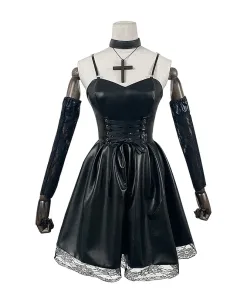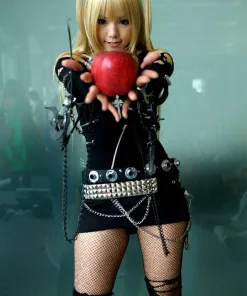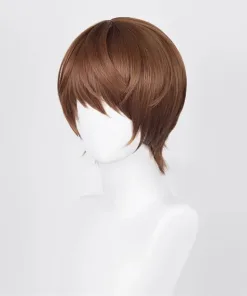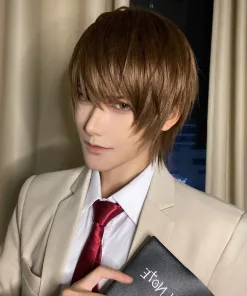$63.34 – $66.37
This product has multiple variants. The options may be chosen on the product page
Death Note: A Phenomenon Beyond the Screen
- What are the rules of the Death Note?
The Death Note has numerous rules, but the primary one is that writing a person's name in the notebook while picturing their face will cause that person to die. The default cause of death is a heart attack if no specific cause is mentioned within 40 seconds of writing the name.
- Who created 'Death Note'?
"Death Note" was created by writer Tsugumi Ohba and illustrator Takeshi Obata.
- How does the Death Note work?
The Death Note works by allowing the owner to kill anyone whose name and face they know, by writing the name in the notebook and specifying a cause and time of death. If the cause of death is not specified, the person will die of a heart attack.
- Who is L in 'Death Note', and what is his role?
L is a world-renowned detective, known for his intelligence and eccentric behavior. In "Death Note," he becomes the primary antagonist to Light Yagami, seeking to prove that Light is the serial killer known as Kira.
- Can the Death Note cause any death, regardless of circumstances?
The Death Note cannot cause just any death. The death must be physically possible and within the realm of what the person could realistically do or experience. Also, the user cannot make a victim's death cause the death of others.
- What are Shinigami, and what role do they play in 'Death Note'?
Shinigami are supernatural beings or "Gods of Death" who originally own the Death Notes. They can extend their own lives by using the notebooks to kill humans. In the series, a Shinigami named Ryuk intentionally drops his Death Note into the human world, which is found by Light Yagami, setting the story in motion.
- What happens to Light Yagami at the end of 'Death Note'?
At the end of "Death Note," Light Yagami is exposed as Kira and is fatally wounded. He attempts to escape but dies from his injuries.
- Are there any spin-offs or sequels to 'Death Note'?
There are a few spin-offs and sequels to "Death Note," including a novel, a few live-action films, a TV drama, and a one-shot manga chapter released in 2020. The live-action films and TV drama adapt the original story with some variations, while the novel and the one-shot manga explore different aspects of the "Death Note" universe.
- What are Shinigami Eyes in 'Death Note', and what is their significance?
Shinigami Eyes allow the user to see a person's name and lifespan above their head, crucial for using the Death Note. However, acquiring this ability requires a human to trade half of their remaining lifespan to the Shinigami associated with their Death Note, reflecting the series' themes of sacrifice and moral choice.
"Death Note," a masterpiece by Tsugumi Ohba and illustrated by Takeshi Obata, transcends the boundaries of a mere Japanese manga series. It's a cultural phenomenon, weaving a complex tale of psychological battles, justice, and supernatural elements that has enthralled a global audience. This article delves into the intricate universe of "Death Note," exploring its rich narrative, characters, and the tremendous impact it has had, particularly in the world of cosplay. From Light Yagami's intense journey to L Lawliet's enigmatic presence, and the iconic looks of Misa Amane, we uncover how this anime thriller captivates and inspires the cosplay community.
Exploring the Death Note Universe
"Death Note," with its anime adaptation and original manga series, has emerged as a cornerstone in Japanese pop culture. It's not just a tale; it's a phenomenon that captures the essence of a psychological battle between good and evil, wrapped in the supernatural. The saga of Light Yagami, armed with the 'notebook of death', presents a riveting narrative of power, morality, and intellect.
The Anime and Manga Phenomenon
The journey of "Death Note" began in the pages of a manga series, rapidly evolving into a much-celebrated anime adaptation. The creative geniuses Tsugumi Ohba (author) and Takeshi Obata (illustrator) brought to life a world where the lines between justice and malevolence blur. Set in Japan, the story propels the audience into a gripping narrative that follows Light Yagami, a high school student who discovers a mysterious notebook - the Death Note. This notebook has the power to kill anyone whose name is written in it, leading to a complex game of cat and mouse between Light and those who seek to stop him.
Key Themes and Concepts
Central to "Death Note" are themes of justice, morality, and psychological warfare. The series introduces us to the supernatural through Shinigami, death gods like Ryuk, who drop the Death Note into the human world. The rules of the Death Note add a layer of intrigue and strategy, making the story not just about the notebook but about the intellect and moral battles of its characters. The default cause of death, a heart attack, becomes a signature of Light's alter ego, Kira, as he seeks to create his version of a just world.
Character Analysis and Cosplay
"Death Note" is not just about its thrilling plot; its characters have become icons in the cosplay world. Each character, from the ingenious Light Yagami to the mysterious L Lawliet, Misa Amane with her Gothic and Lolita styles, and the quirky Ryuk, offers a wealth of inspiration for cosplayers.
Main Characters and Their Influence on Cosplay
Light Yagami, with his transition from a high-achieving student to the notorious Kira, provides a dynamic range for cosplay. His school uniforms and later more mature attire reflect his character development. L Lawliet, known for his unique posture and minimalist wardrobe, challenges cosplayers to embody his unparalleled intelligence and eccentricity. Misa Amane, a popular character for cosplay, brings in elements of Gothic and Lolita fashion, offering a diverse palette from her schoolgirl look to more elaborate, leather-laden outfits.
Cosplay Elements and Popular Costumes
Cosplay of "Death Note" characters often revolves around key props and costumes. The Death Note notebook itself is a must-have accessory, often paired with apples as a nod to Ryuk's favorite snack. Wigs are crucial in getting characters right, from Light's brown hair to L's unruly black locks and Misa's blonde pigtails. School uniforms are a staple, but it's the unique elements like Misa's leather costumes or L's simple white shirt and jeans that make each cosplay stand out.
The Psychological and Moral Dimensions
The psychological depth and moral questions posed by "Death Note" are what set it apart from other manga and anime series.
The Duality of Light Yagami
Light Yagami's character is a fascinating study in duality. Initially seen as a beacon of hope and justice, his gradual descent into moral ambiguity and megalomania is a central theme. His journey from a high school student to the feared Kira is a goldmine for character analysis, making him a favorite in the cosplay community for his complexity and evolution.
L Lawliet's Role as a Counterpart
L Lawliet serves as the perfect foil to Light. His unconventional detective methods, coupled with his own moral ambiguity, add layers to the storyline. His battle of wits with Light is not just a chase but a profound examination of what it means to seek justice. L's distinct look and mannerisms make him a captivating character for cosplayers to interpret.
Cultural Impact and Fan Engagement
"Death Note" has left an indelible mark on anime culture, influencing countless other media and fostering a vibrant fan community.
Fan Theories and Discussions
The series has sparked endless debates and theories among fans. Discussions range from the ethical implications of the Death Note to the intricate strategies employed by characters. This engagement has fostered a community that not only celebrates the series but also explores its deeper meanings.
The Legacy of Death Note
The legacy of "Death Note" is evident in its enduring popularity and the impact it has had on anime culture. It has inspired other creators and continues to be a benchmark in storytelling, character development, and thematic depth.








